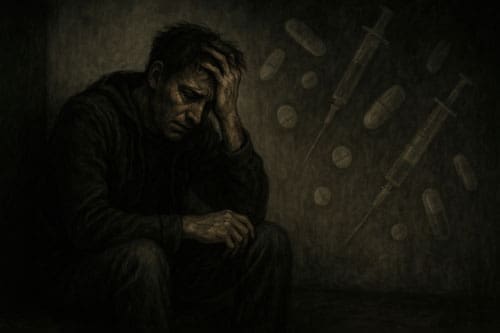How Medication-Assisted Treatment Reprograms the Brain to Break Addictive Habits
Patient-Friendly Guide
Introduction
Have you or any of your loved ones tried quitting drugs multiple times and experienced painful withdrawal symptoms and strong cravings that led to relapse? Medication assisted treatment (MAT) can help you break the cycle. Within weeks of starting MAT, cravings become more manageable, and people struggling with addiction can start rebuilding their lives. While traditional MAT programs use medications like buprenorphine or methadone, some people explore alternative approaches offered at an ibogaine clinic, where a different kind of neurological reset is pursued. In this article, we’ll explore how MAT works and how it can help rewire the brain to overcome addiction.

What is Medication Assisted Treatment?
Medication Assisted Treatment (MAT) includes a combination of FDA-approved medicines with behavioral therapy to treat substance use disorder. This treatment reduces cravings and helps individuals manage withdrawal symptoms. Many people have achieved long-term recovery and regained stability in their lives with this approach. The goals of MAT include the following:
- Increasing patient survival rates
- Decreasing the negative behaviors associated with substance use disorder
- Increasing patients’ abilities to gain or maintain employment
- Increasing treatment retention rates
What Medicines are used for MAT?
MAT involves using diverse medications for a variety of substance dependencies. Here are a few medicines used for MAT:
- Methadone: Methadone is a long-lasting, synthetic opioid that is often used to treat dependency on heroin. It reduces pain and helps people relax, but does not cause the feeling of being high.
- Buprenorphine: This narcotic treats pain as well as addiction to pain medication. Buprenorphine offers flexible dosing schedules compared to methadone. Unlike methadone, which must be administered at a clinic, buprenorphine
- Acamprosate: Acamprosate helps people with alcohol use disorder. Acamprosate helps patients maintain their sobriety but is not meant to be taken during the withdrawal period.
- Naltrexone: This drug blocks the euphoric effect of opioids and alcohol and reduces the desire for these substances. Unlike methadone and buprenorphine, it does not activate opioid receptors.
How Does MAT Help Break Cycles of Addiction?
Here is how the medications used in MAT help patients overcome addiction:
- Decreases cravings: By helping manage cravings, MAT helps people stay sober and regain control of their lives.
-
- Withdrawal symptoms management: Most MAT medicines alleviate withdrawal symptoms, making the recovery process a lot smoother and reducing the risk of relapse.
- Improved treatment retention: Patients taking advantage of MAT are more likely to stay engaged with other treatment programs, providing them with multiple forms of support and substance use disorder treatment.
Therapeutic Interventions Combined with MAT
These therapeutic interventions can be used in combination with FDA-approved MAT medications to support recovery from substance use disorder. While ibogaine clinic offers alternative therapies, they are not part of standard MAT programs approved by most health authorities
- Cognitive Behavioral Therapy: CBT, or cognitive behavioral therapy, helps individuals identify and change unhelpful behaviors and thoughts related to their substance use disorder.
- Group Therapy: This can include a variety of groups and programs designed to help people deal with the specific traumas and factors involved in substance use disorder. Group therapy can be incredibly empowering, helping to break the isolation often associated with addiction.
- Motivational Enhancement: Motivational enhancement therapy, also known as motivational interviewing, is a therapeutic approach that helps you identify and resolve doubts regarding breaking free from substance use. It helps individuals stay motivated and engaged in treatment.
- Community Reinforcement Approach: The community reinforcement approach (CRA) is a psychosocial intervention for people who are dependent on substances that helps them recognize reasons for making changes in their lives and finding healthier ways of coping with stress or triggers to substance use.

Misconceptions About MAT
Let’s debunk some common myths about MAT:
-
MAT means substituting one drug for another:
The most common myth about MAT is that prolonged use of medications, which include methadone, buprenorphine, or naltrexone, is like replacing one addiction with another. However, the fact is that MAT medications are not a substitute for illicit substances. When prescribed and carefully regulated, they can reduce cravings and block the euphoric effects of drugs. MAT medications are not psychoactive when taken under medical supervision. Healthcare professionals closely monitor the patients undergoing MAT to ensure safe outcomes.
-
You are not sober if you use MAT:
Many people believe that MAT and sobriety are mutually exclusive, which is not true. MAT medications do not disturb an individual’s normal life or create a feeling of being high.
-
MAT medications can potentially be misused:
Another misconception about MAT is that individuals undergoing treatment can misuse medications. However, MAT medicines are safe and effective when used as directed by the physician. While there is a potential for misuse, it is limited. Some medicines, like Suboxone, are formulated to discourage misuse by preventing the pleasurable effects.
-
There is no proof that MAT is better than abstinence:
Some people say that there is no evidence that MAT is better than complete abstinence. Also, some addiction treatment programs are based on the concept that complete abstinence from the substance is the only way to recovery. However, the evidence does not support the fact that abstinence is the most effective method of treating opioid addiction. In fact, MAT is so effective that the FDA is encouraging the development of more MAT medications. According to the U.S. Department of Health and Human Services (HHS), the evidence for the efficacy of MAT is clear, and these medications can serve a vital role in defeating substance abuse.
Ibogaine Treatment as an Alternative to MATal
Ibogaine is a psychoactive drug derived from the iboga plant and has been used for treating opioid addiction for several decades. Due to its ability to reduce cravings, ibogaine is used in detoxification treatments in ibogaine clinics. Some people recommend ibogaine as an alternative to MAT. A major advantage of ibogaine therapy is that it demonstrates a high success rate after a single use, unlike MAT medications, which have to be used for a prolonged time.
Opt for Medication Assisted Treatment to Manage Substance Use Disorder
Medication assisted treatment (MAT) can be very helpful in breaking the cycle of addiction. Combined with therapy, medicines like methadone, buprenorphine, and acamprosate help reduce cravings and alleviate withdrawal symptoms for individuals combating substance use disorder. Common therapies that can support MAT include cognitive behavioral therapy, group therapy, motivational enhancement, and a community reinforcement approach.

Frequently Asked Questions:
1. What is Medication-Assisted Treatment (MAT), and how does it work?
Medication-Assisted Treatment combines FDA-approved medications with behavioral therapies to treat substance use disorders. The medications reduce cravings and withdrawal symptoms, helping individuals stay engaged in recovery and avoid relapse.
2. Are MAT medications just replacing one drug with another?
No. MAT medications like methadone, buprenorphine, and naltrexone are carefully regulated and prescribed to stabilize brain chemistry without producing a high. They help individuals manage addiction safely, not substitute one addiction for another.
3. What kinds of medications are used in MAT, and what are their purposes?
Common MAT medications include methadone (for opioid addiction), buprenorphine (for opioid and pain medication dependence), acamprosate (for alcohol dependence), and naltrexone (which blocks the effects of opioids and alcohol). Each is used based on the specific substance and treatment needs.
4. Is therapy necessary if I’m taking medication through MAT?
Yes. MAT is most effective when combined with behavioral therapies like cognitive behavioral therapy, group therapy, motivational enhancement, and the community reinforcement approach. These interventions address the psychological and emotional aspects of addiction.
5. How does ibogaine treatment compare to traditional MAT?
Ibogaine, a plant-derived psychoactive substance, is an alternative approach used in some clinics to reduce cravings and interrupt addiction cycles. Unlike traditional MAT, ibogaine is not FDA-approved, and its use carries more risks and lacks the regulatory support and long-term research backing MAT programs have.
References:
- Substance Abuse and Mental Health Services Administration. (2020). Medication-Assisted Treatment (MAT). https://www.samhsa.gov/medication-assisted-treatment
- National Institute on Drug Abuse. (2018). Medications to Treat Opioid Use Disorder Research Report. https://nida.nih.gov/publications/research-reports/medications-to-treat-opioid-addiction/overview
- Volkow, N. D., Frieden, T. R., Hyde, P. S., & Cha, S. S. (2014). Medication-assisted therapies—tackling the opioid-overdose epidemic. New England Journal of Medicine, 370(22), 2063–2066. https://doi.org/10.1056/NEJMp1402780
- Mattick, R. P., Breen, C., Kimber, J., & Davoli, M. (2014). Buprenorphine maintenance versus placebo or methadone maintenance for opioid dependence. Cochrane Database of Systematic Reviews, (2), CD002207. https://doi.org/10.1002/14651858.CD002207.pub4
- Center for Substance Abuse Treatment. (2005). Medication-assisted treatment for opioid addiction in opioid treatment programs (Treatment Improvement Protocol Series No. 43). Substance Abuse and Mental Health Services Administration.
- Krupitsky, E., Nunes, E. V., Ling, W., Illeperuma, A., Gastfriend, D. R., & Silverman, B. L. (2011). Injectable extended-release naltrexone for opioid dependence: A double-blind, placebo-controlled, multicentre randomised trial. The Lancet, 377(9776), 1506–1513. https://doi.org/10.1016/S0140-6736(11)60358-9
- American Society of Addiction Medicine. (2020). National practice guideline for the treatment of opioid use disorder. https://www.asam.org
- Alper, K. R., Lotsof, H. S., & Kaplan, C. D. (2008). The ibogaine medical subculture. Journal of Ethnopharmacology, 115(1), 9–24. https://doi.org/10.1016/j.jep.2007.08.034
- Mash, D. C., Kovera, C. A., Buck, B. E., Norenberg, M. D., Shapshak, P., Hearn, W. L., & Sanchez-Ramos, J. (1998). Medication development of ibogaine as a pharmacotherapy for drug dependence. Annals of the New York Academy of Sciences, 844(1), 274–292. https://doi.org/10.1111/j.1749-6632.1998.tb08244.x
- U.S. Department of Health and Human Services. (2016). Facing Addiction in America: The Surgeon General’s Report on Alcohol, Drugs, and Health. https://addiction.surgeongeneral.gov/


